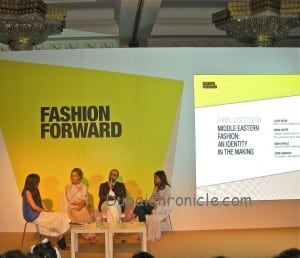Middle Eastern Fashion Industry Needs to Go Back to Its Roots, Experts Say
 There is no doubt that the Middle East is a unique region that has its own traditions, culture and charm. The originality of the people who inhabit this part of the world shines in everything they do, as well as in everything they are. The same goes for the fashion industry in the Middle East. It has its own characteristics and trademarks that can be imitated but never replicated. However, lately, the region is commonly linked to clichéd in design and style, such as the heavy makeup look.
There is no doubt that the Middle East is a unique region that has its own traditions, culture and charm. The originality of the people who inhabit this part of the world shines in everything they do, as well as in everything they are. The same goes for the fashion industry in the Middle East. It has its own characteristics and trademarks that can be imitated but never replicated. However, lately, the region is commonly linked to clichéd in design and style, such as the heavy makeup look.
This was the topic of one of the panel discussions during the first edition of Dubai’s Fashion Forward this year. During the four-day event spoke many well-known personalities in the fashion world, like designer Rabih Kayrouz and fashion editor Lousie Nichol.
According to Louise Nichol, Editor-In-Chief for Harper’s Bazaar Arabia, the truth is that the Middle East and Dubai, in particular, is no longer what it used to be a decade ago. Nichols believes that there is a new generation of fashion followers in the region who are more open to mix and combine a variety of styles. Nevertheless, she adds that glamour and beauty are always present in Middle East’s fashion: “Glamour defines the Middle Eastern fashion, together with beauty. For a magazine editor it is a joy to work in this market.”
The editor also shared that today’s fashion industry is governed more by consumers than designers. “Consumers drive the market nowadays more than designers,” explained Nichol. The editor of Harper’s Bazaar Arabia added that consumers in the Middle East are more interested in regional celebrities than the international ones. As a result, the local media should turn its attention to topics that actually interest this regional audience.
Lebanese designer Rabih Kayrouz also discussed consumers and the Middle Eastern fashion industry. “Middle Eastern consumers are hard to impress,” shared Kayrouz. The designer explained that women in the region have a different attitude towards fashion.
“Middle Eastern ladies think that there is a red carpet everywhere,” said Kayrouz. According to him, that means that they need outfits that will show more identity. For Rabih Kayroz, the quickest path to establishing a fashion identity is paved with traditions. The Paris-based designer believes that the Middle East needs to go back to its roots: “It is about time to bring out our beautiful traditions.”
Kayrouz is confident that this is not a mission impossible, since it was already successfully done in the past. He even gave a few examples: “Saint Laurent brought kaftans and tunics back. Why won’t designers bring back our traditional designs now?”
The designer also outlined the important role of Zayan Ghandour in the rediscovery of the Middle Eastern fashion traditions and translating it to younger generations of designers.
Another big topic during the panel discussion was the media’s relationship with fashion designers. According to Louise Nichol, the media does not give new designers a chance: “Designers should be well-established before media takes the risk to discuss them.” Nichol claims that most designers that are recognized by the mainstream media have a strong team behind them and many representatives. In addition, the media today searches for fashion names that “have commerciality.” However, Louise Nichol believes that young designers also should be given some media recognition.
Rabih Kayrouz also touched upon the topic saying that the task rediscovery of the Middle East’s identity should not be embraced by designers only, but also by editors and journalists: “The Middle Eastern fashion identity should be rediscovered and editors and journalists should be proud to rediscover this identity.”






















![The Square at Nad Al Sheba Gardens Now Open hope tax season treated you well! Just checking in—ready to refocus on growing your business? I remember how we discussed scaling your [specific aspect of their business, e.g., online presence] but paused due to time constraints. We now offer a streamlined 6-month plan that delivers real results without adding to your workload. Let me know if you'd like to chat—I’d love to help you pick up where we left off!](https://www.dubaichronicle.com/wp-content/uploads/2024/11/The-Square-5-218x150.jpg)









